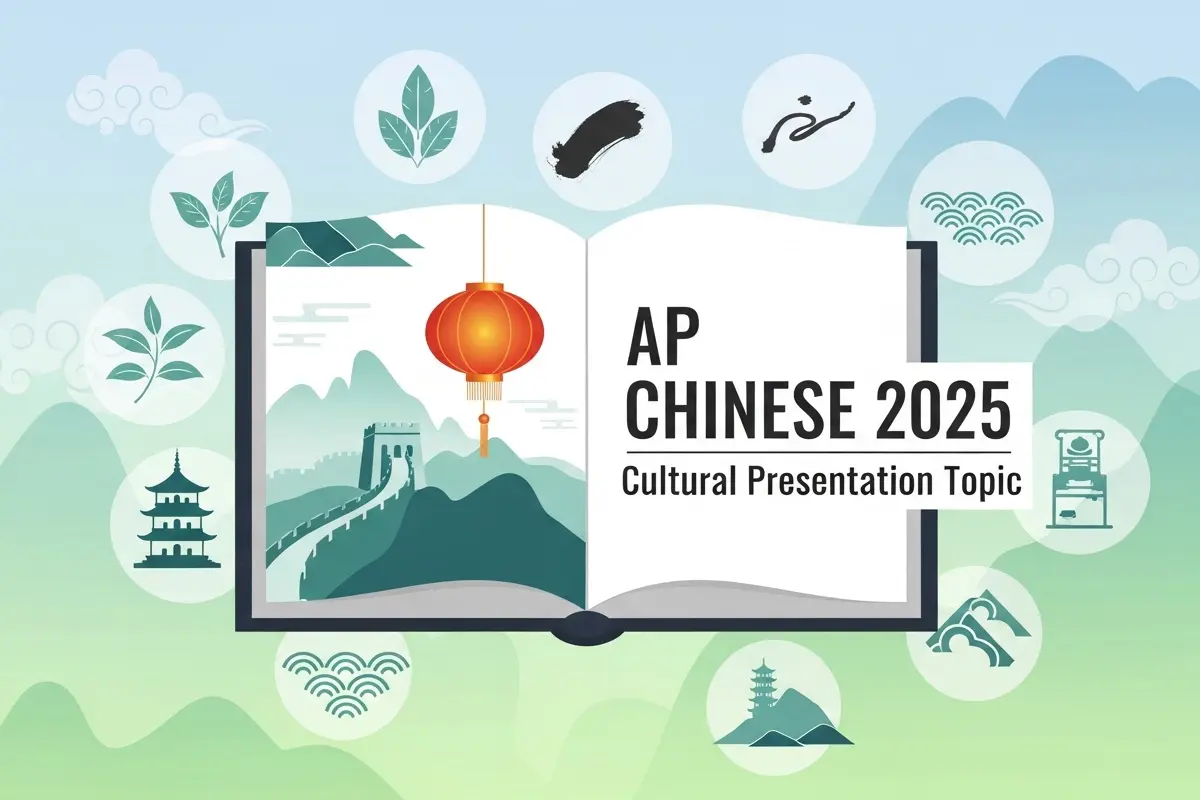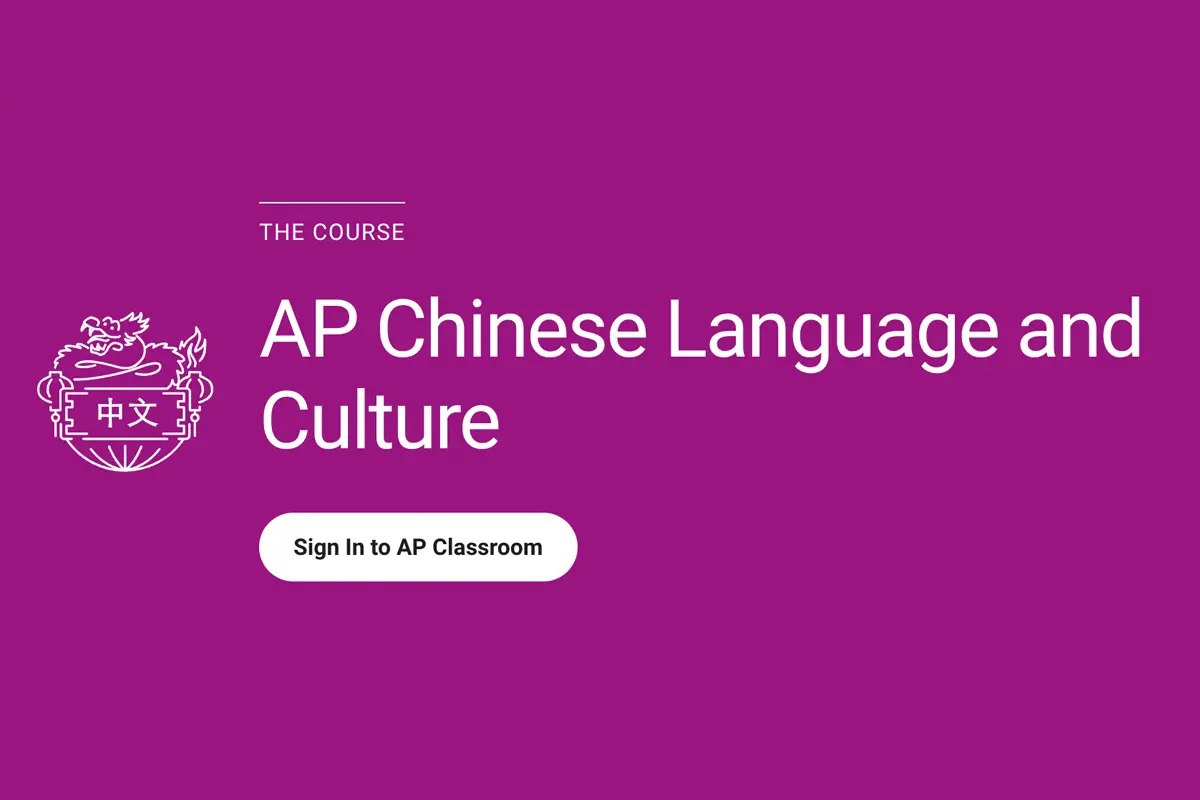
TL;DR
- The AP Chinese 2025 cultural presentation topic asks you to describe one cultural aspect clearly in Mandarin.
- Choose a specific, culturally rich topic that fits well into a 2-minute structured response.
- Strong topics include festivals, traditional arts, daily customs, and historical values.
- Use examples, personal experience, and cultural comparison to score higher.
- Clear structure and confident delivery matter more than the specific topic.
Table of Contents
Open Table of Contents
- AP Chinese 2025 Cultural Presentation Topic
- What Exactly Is the Cultural Presentation in AP Chinese?
- Best AP Chinese 2025 Cultural Presentation Topics
- How to Choose the Best Topic for Your AP Chinese Cultural Presentation
- Example 2-Minute Presentation Structure
- FAQ (Merged Q&A Section)
- Sample High-Scoring Topics with Ready-to-Use Phrases
AP Chinese 2025 Cultural Presentation Topic
The AP Chinese 2025 cultural presentation topic requires a two-minute Mandarin explanation of a cultural product, practice, or perspective from the Chinese-speaking world. According to the College Board’s AP Chinese Course and Exam Description, this task evaluates your ability to demonstrate cultural knowledge, organize ideas logically, and speak clearly in Mandarin.
Choosing a narrow, meaningful topic—one with history, symbolism, and personal relevance—helps you speak fluently and confidently under the 2-minute time limit.

What Exactly Is the Cultural Presentation in AP Chinese?
The cultural presentation is part of the Speaking section. You will:
- Receive one topic prompt.
- Prepare for 4 minutes.
- Speak for 2 minutes in Mandarin.
- Present a cultural product, practice, or perspective from the Chinese-speaking world.
As the College Board emphasizes, responses are scored on:
- Cultural knowledge
- Language control
- Organization & clarity
- Task completion
A focused cultural topic—such as a festival or value system—helps you address these criteria efficiently.
Best AP Chinese 2025 Cultural Presentation Topics
Below are strong, exam-friendly topics with clear cultural significance. Each one is narrow enough to support a well-structured 2-minute response.
Traditional Festivals
Traditional festivals are ideal because they contain clear rituals, historical origins, and symbolic meaning. For example:
- 春节 (Spring Festival) — reunion dinners, red envelopes, firecrackers.
The Ministry of Culture and Tourism provides rich background on how 春节 symbolizes renewal and unity. - 中秋节 (Mid-Autumn Festival) — mooncakes, family unity, the Chang’e legend.
- 端午节 (Dragon Boat Festival) — zongzi, dragon boat races, Qu Yuan.
UNESCO lists Duanwu Festival as part of the world’s intangible cultural heritage.
Festivals are predictable, structured, and culturally deep—perfect for AP responses.
Daily Cultural Practices
These topics are relatable and easy to explain:
- 饮茶文化 (Tea culture) — types of tea, health benefits, social meaning.
- 敬老文化 (Respect for elders) — rooted in Confucian values.
- 中国的节俭观念 (Frugality) — traditional savings habits and value systems.
Daily customs offer simple examples that support comparison with Western culture.
Arts & Aesthetics
Traditional arts have clear structures, aesthetics, and symbolism:
- 书法 (Calligraphy) — balance, brush technique, and personal expression.
Historical development is discussed in our own guide Evolution of Chinese Characters from Oracle Bone to Modern Script. - 京剧 (Peking opera) — face paint, singing style, cultural symbolism.
- 中国园林 (Classical gardens) — Suzhou gardens, harmony with nature.
If you want to reference Chinese writing in your presentation, you can learn practical character strategies in How to Memorize Chinese Characters Effectively.
Food Culture
Food topics are relatable and always engaging:
- 八大菜系 (Eight major cuisines) — Sichuan spice vs. Cantonese lightness.
- 饺子文化 (Dumplings) — New Year symbolism, regional filling differences.
- 早餐文化 (Breakfast foods) — soy milk, yóutiáo, congee.
These topics let you provide vivid examples and cultural comparisons.
Historical / Philosophical Topics
Great for advanced learners:
- 孝 (Filial piety) — foundational Confucian value influencing family structure.
- 和为贵 (Harmony first) — a key social perspective often cited in Confucian texts.
- 礼仪文化 (Etiquette) — gift-giving, greetings, politeness norms.
These topics demonstrate deeper cultural understanding and perspective.
How to Choose the Best Topic for Your AP Chinese Cultural Presentation
Choose a topic you truly understand
Authenticity makes it easier to speak confidently.
Pick a narrow theme
Broad topics like “Chinese food” are too general.
A focused topic like “Why dumplings symbolize unity in Spring Festival” is ideal.
Look for topics with:
- Clear historical roots
- Modern relevance
- Easy examples
- Personal connection
This combination helps deliver a complete and structured response.
Example 2-Minute Presentation Structure
A reliable structure helps you stay organized:
-
Introduce the topic clearly.
“今天我要介绍的文化主题是中秋节。” -
Explain what it is.
“中秋节是中国最重要的传统节日之一。” -
Describe key practices.
“家人会一起吃月饼、赏月、团圆。” -
Explain cultural meaning.
“它代表家庭、团结,也表达对亲人的思念。” -
Share your experience.
“我们家每年都会寄月饼给亲戚。” -
Compare with your own culture.
“和美国的感恩节一样,中秋节也强调家庭的重要性。” -
Close with a recap.
“总的来说,中秋节体现了中国人对家庭团圆的重视。”
FAQ (Merged Q&A Section)
What’s the easiest AP Chinese cultural presentation topic?
Festivals such as 春节 and 中秋节, because they have clear rituals, symbolism, and cultural depth.
What topics are too broad?
“Chinese food,” “Chinese history,” or “Chinese festivals” are too large. Narrow them down to one specific cultural element.
Can I talk about modern topics like WeChat or high-speed rail?
Yes. The College Board confirms that modern cultural products also qualify.
Do I need to compare Chinese culture with my own?
Comparison is not mandatory, but it improves scores by showing cultural perspective.
Should I memorize advanced phrases?
No. Clear Mandarin and well-organized ideas matter more than difficult vocabulary.
Sample High-Scoring Topics with Ready-to-Use Phrases
| Topic | Why It Scores Well | Useful Phrases |
|---|---|---|
| 中秋节 | Tradition + symbolism | 团圆、赏月、传统文化 |
| 饺子文化 | Relatable + regional variation | 北方、团圆、吉祥 |
| 书法 | Visual + historical context | 美学、艺术、平衡 |
| 敬老文化 | Strong perspective-based topic | 孝顺、传统价值观 |
| 茶文化 | Simple + deep historical roots | 乌龙茶、绿茶、健康 |